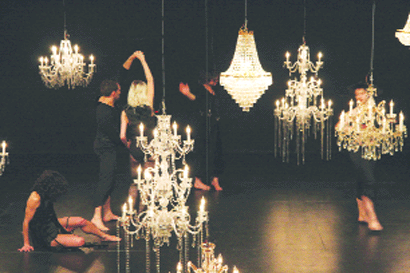Opposing and embracing the obstruction of light
The confusing mob scene at The Kitchen’s house doors foreshadowed what Maria Hassabi had in store. As we entered we already tasted the harried city she would mirror in “Still Smoking.”
Excess is the vision for this piece choreographed by Cyprus-born Hassabi, who has lived in New York since ‘89. Her set consisting of 19 crystal chandeliers is more redolent of a Bowery lighting showroom than the Ritz. They eerily go on and off, dimmed to a warm glow or reduced to a mass of glass reflecting the light from surrounding fixtures—the design of Joel Fitzpatrick.
Six dancers are dressed for the limelight, reflecting Hassabi’s passion for fashion, all in black. ThreeAsFour did the costume designs. Hassabi also choreographs for the runway and her groupings suggest a W centerfold or a fashion show. Performed with fitting ennui, the dancers’ movement is eye-popping, pedestrian, and traffic stopping.
As if languishing in a painting by Boucher, one of the men stretches on the sidelines and blows a fragile kiss. Hristoula Harakas’ sweet chains of pirouettes, with arms raised and fingers splayed, are insular, providing no entrance. Jessie Gold lengthens in twisty arabesques looking very tall and trim. She sings a few notes in a mysterious voice.
In Ben Brunnemer’s sound score I hear something like the intro for “That Girl,” or the song “Downtown.” It slows to a siren’s whine like WB “Looney Tunes” as things get more claustrophobic. The mix is Lemonjelly, Dorit Chrysler’s music, Brunnemer’s, and Godspeed You Black Emperor!
Hassabi has said she’s focusing less on the performers individuality; she’s engaging us with the dance’s tight structure, look, and mood. Still, David Adamo, actually a visual and performance artist, flexes with great presence. It can’t be denied there’s extreme frustration expressed by the six expressionless dancers, which climaxes in Harakas’s fight with the column she’s standing against.
The cast, though small, fills the stage and a dancer creaking down the center aisle somehow makes us feel part of the crowd. Harakas coughs at us unapologetically. The stifling atmosphere recalls the subway where fellow passengers are too near and very upright as if to protect themselves against dreaded germs. Hassabi’s reason for embracing ballets verticality?
Hassabi is on her butt center stage in black briefs slicing the air with scissor legs. She removes the briefs and her nakedness looks valorous as well as vulnerable. A clothed platinum blonde Caitlin Cook rolls onto her, covering her lifeless body. Several clutching embraces are cell-phone-camera moments, brief couplings we’re privy to.
Pelvises pump in unison. It’s like looking in a window at Bally, but with obvious sexuality. Ori Flomin could pass for an average hunk but is also a respected choreographer. He’s the only one with a facial expression. It’s a sneer. The others are icy-hot, as in Sarah Michelson’s recent “Daylight.” Michelson curated Hassabi’s evening for the Kitchen. Both pieces can be read as a very personal response, posing as surface.
Christopher Wheeldon and the Brooklyn collaborative Robbinschilds used chandeliers as a dramatic Romantic element—that is romance gone awry. Here it goes for Baroque? Rococo? The stagecraft takes on a starring role with the lighting, movement, and music. It’s no longer opulence but obstacle.
The ballroom is populated by the group jumping in unison, facing us when the lighting gets low—literally, and in lumens. They pair off dancing formidably in the troublesome forest of low-lying crystal. It’s quite ominous, as was John Jasperse’s “California” with its architectural blimp breaking at the rivets.
Hassabi’s unsettling work is as mournful and alienating as the show of photos in the Kitchen’s upstairs gallery by Yto Barrada about the timely issue of walls between humans created by border control. The dance that’s impenetrable is more troubling.
Though Hassabi feeds us with suspense, teasing us with possibility, finally and at best, the grim visage that is “Still Smoking” begs for resolution, eruption, a change.
gaycitynews.com



































